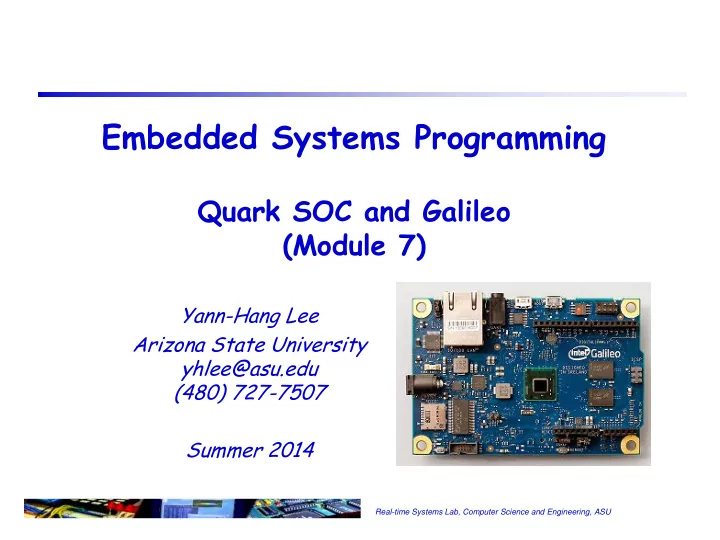

Embedded Systems Programming Quark SOC and Galileo (Module 7) Yann-Hang Lee Arizona State University yhlee@asu.edu (480) 727-7507 Summer 2014 Real-time Systems Lab, Computer Science and Engineering, ASU
Current Processor Design Moore’s law continues to hold true, transistor counts doubling every 18 months But can no longer rely upon increasing clock rates and instruction- level parallelism to meet computing performance demands Semiconductor device fabrication process 65 nm – 2006, 45 nm – 2008, 32 nm – 2010, and 22 nm – 2012 How to best exploit ever -increasing on- chip transistor counts? Multi- & many-core (MC) devices are new technology wave exploiting explicit parallelism in the new devices Size and Power constraints 1 Real-time Systems Lab, Computer Science and Engineering, ASU
Intel Processors X86 32/64 architecture 486 – first pipelined x86 design Pentium – the first x86 superscalar CPU Processors for Server (Xeon), desktop (Core i3/i5/i7), mobile (Core i3/i5/i7), and embedded (Atom) All of them support hypervisor (VM) Differences CPUs, memory, and interconnection bandwidth reliability (quality of dies) and form factor power and thermal requirements Uses available clock cycles and power, not to push up higher clock speeds and energy needs 2 Real-time Systems Lab, Computer Science and Engineering, ASU
Galileo Board 400MHz Quark SoC 256MB DDR3 Ethernet USB Host Port MicroSD Support I2C , SPI Support PCI Express Mini Cards Serial Connectivity GPIO Linux on Board Source: http://www.intel.com/content/www/us/en/intelligent-systems/galileo/galileo-overview.html 3 Real-time Systems Lab, Computer Science and Engineering, ASU
Intel Quark SoC X1000. SOC – CPU core (x86) cache, internal memory (flash, SRAM) IO interfaces and external buses interconnection or switches misc (clock, JTAG) Chip size, power and pins 32nm process in 1 st Quark one-fifth the size and one-tenth the power of low-end Atom chip 393 solder balls on 15mm 2 5 power rails (3.3V, 1.8V, 1.5V, 1.05V, 1.0V) 4 Real-time Systems Lab, Computer Science and Engineering, ASU
Quark Core Internal Architecture 32-bit RISC integer core Single cycle execution Instruction pipelining Floating-point unit Cache with cache consistency support (16-Kbyte for both data and instructions) Memory management unit 5 Real-time Systems Lab, Computer Science and Engineering, ASU
486 Pipeline 6 Real-time Systems Lab, Computer Science and Engineering, ASU
Pins in Quark Example: High Speed UART Interface, SIU1_RDX SIU1_TXD Default Buffer State Signal Name Dir Term Power Type S4/S5 S3 Reset Enter S0 SIU0_RXD I 20k(H) 3.3V CMOS3.3 Off Off Pull-up Pull-up SIU0_TXD O - 3.3V CMOS3.3 Off Off VOH VOH Six different power states S0 – the system is completely powered ON and fully operational S5 – the system is completely powered OFF S1, S2, S3 and S4 – sleeping states, the system appears OFF because of low power consumption and retains enough of the hardware context to return to the working state I n Galileo schematics 7 Real-time Systems Lab, Computer Science and Engineering, ASU
IO Expander and GPIO Multiplexing CY8C9540A – I2C interfaced expander with 40 I/O data pins (ports 0-5) independently configurable as inputs, outputs, bi-directional input/outputs, or PWM outputs To configure a pin an I2C control message to the chip which includes a register address 8 Real-time Systems Lab, Computer Science and Engineering, ASU
Recommend
More recommend